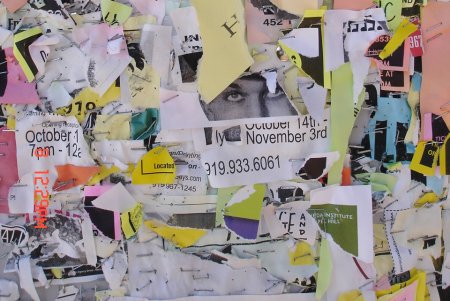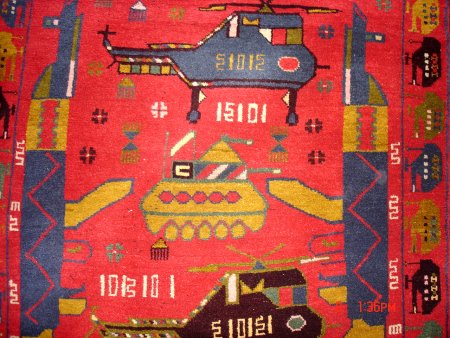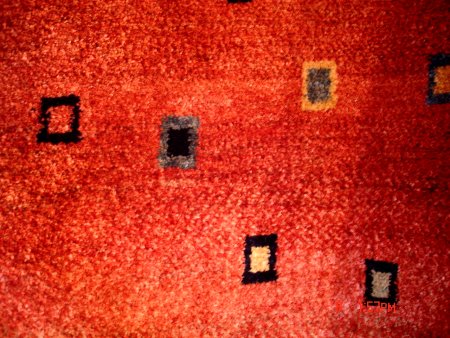
Flier kiosks are a common sight in college towns. But at this particular time (i.e., before the semester has started), none of the kiosks in Chapel Hill seemed to have any actual flyers, just remnants of things from earlier. The result is a somewhat disconcerting collage.
But on to our real subject:

Would you buy a rug with the design above?
On a lark, we went into a place in Carrboro that sells Persian rugs. The salesman there was very enthusiastic, and showed us all kinds of rugs made in Iran, Afghanistan, Turkey, and Pakistan. Most of them had familiar, Persian designs, but some rugs from Afghanistan were radically different. According to him, the women who weave ones such as the above were asked by the merchants to simply portray whatever would best represent their experience -- and the result is tanks (and personal carriers), helicopters, and automatic rifles (AK-47 and AK-74). These 'war rugs' are apparently not of very high value for the general consumer, as people don't want to put them on the floor in their houses.
I was drawn to them, even though I felt, even then, that the designs were ugly. But I would feel queasy about actually buying and displaying such a rug in my apartment: it's hard to imagine how such an expression of suffering and rage could ever be transformed into a decorative element for a comfortable (and, needless to say, gun-free) American home. So maybe one could justify buying a 'war rug' as a work of art, but not as an actual, functional rug?
I don't think so. There is a company (warrug.com) that sells these rugs exclusively (indeed, many of the designs are similar to the ones we saw in Carrboro). I find the language on the site advertising the rugs a little troubling. It's also notable that designs such as the above are often copied and produced elsewhere in the region: all for the export market (see especially this page of this site for more on that). At the very least, this additional information casts doubt on the romanticized account of the war rugs we got from the salesman: this is not the authentic voice of Afghan women's protest, but a sizeable industry oriented to a particular niche of western consumers.
There is, however, an earlier generation of war rugs that were produced during the Soviet invasion itself, according to Graham Gower's Afghan War Rugs site. Many of these were 'protest' rugs, which were sold to raise money for the Mujahideen. Some of them tell pictographic stories of particular battles against the Soviets, or record the exploits of Ahmed Shah Massoud. These do seem somewhat more interesting to me than the generic 'weapons' war rugs, though the pictographic battle rugs are clearly relics of a very particular historical conflict.
Far and away the most informative site on war rugs is the cluster of articles by Jon O'Callaghan of New Hampshire, who analyzes the rugs he sells quite closely. You can learn about different kinds of wool in the rugs, different knots used by weavers in Herat (Afghanistan) and Mashad (Iran), as well as considerable detail on the types of weapons represented -- often with high graphical accuracy -- in the various types of war rugs. O'Callaghan's site is poorly organized, but if you click around you will find out lots of interesting things about war rugs.
The more I learn about war rugs, the more I dislike them. Our sales-guy in Carrboro also showed us traditional rugs from Hereke, as well as the abstract Gabbeh style from Southern Iran. Since I'm not sure I'll ever be able to afford a vintage Hereke rug, if I do ever buy a Persian or Turkish rug, it will probably be a Gabbeh:

* * * *
Incidentally while on this quick jaunt in NC, we also went to the Duke Gardens, which is worthwhile even in winter: go to Flickr to see some other rug pictures, as well as shots from the gardens in winter.